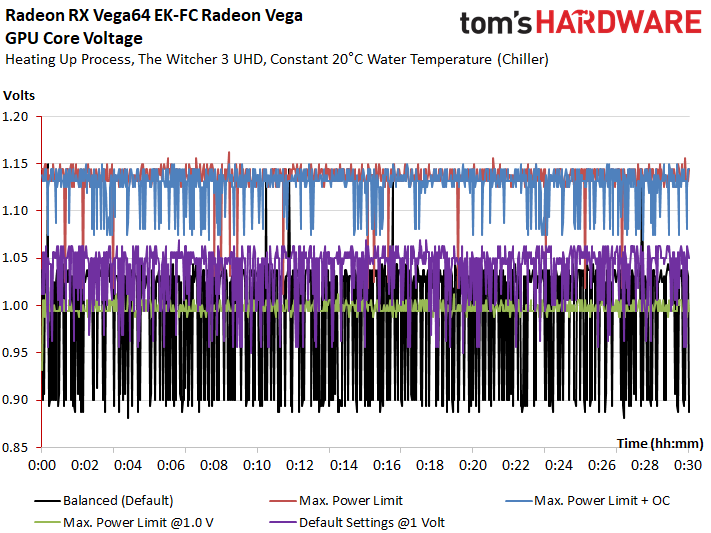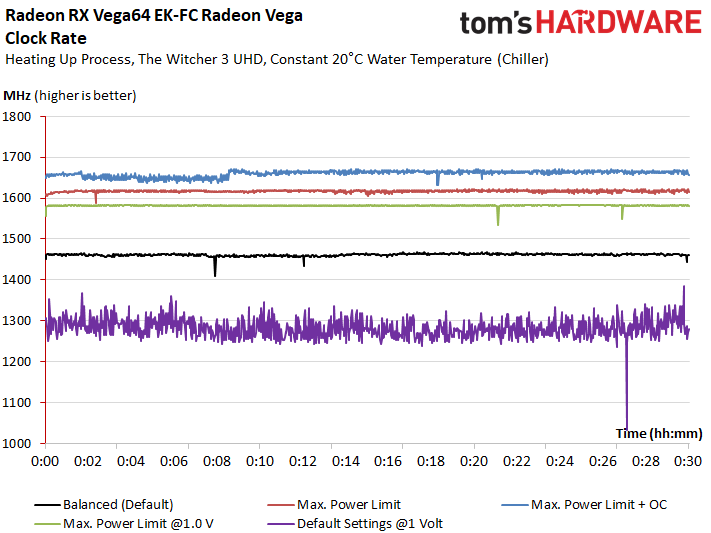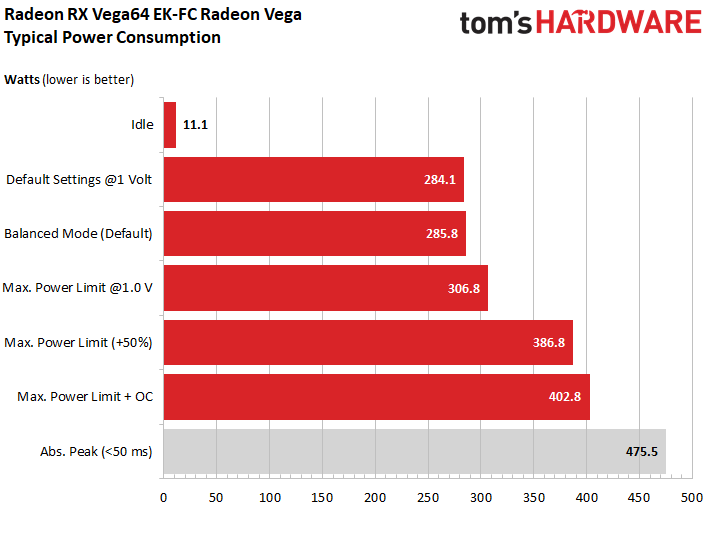Does Undervolting Improve Radeon RX Vega 64's Efficiency?
Voltages, Frequencies & Power Consumption
Voltages & Frequencies
We already know that AMD's Radeon RX Vega 64 derives significant benefits from AVFS due to the telemetry’s efforts to keep things as balanced as possible. For instance, the graph below shows that the curves for two runs at the maximum power limit are almost exactly on top of each other. This is by design. However, the other three curves are a lot more interesting.
This is why we collected them in a second comparison graph of their own. Radeon RX Vega 64 and AVFS can make all the adjustments they want in Balanced mode.
Also, check out the two curves representing a manual 1.0V voltage setting. This is where things get weird. At its maximum power limit, RX Vega 64 does average 1V. However, at the default power limit, it overvolts significantly more than when it’s set to automatically control its voltages, and doesn’t manage to decrease them with changing load states as intricately as before. Consequently, not only does the effective voltage across our run end up well above the manually-set 1.0V, but also well above the Balanced mode’s effective voltage!
This behavior has a negative effect on the GPU’s frequency. It’s clear to see that our manual voltage setting without an increased power limit ends up being counterproductive; this combination effectively cancels the telemetry’s efforts. On the other hand, the same manual voltage setting, when combined with a maxed-out power limit, results in stable and usable clock rates. They're only slightly lower than those produced by the automatic setting, while consuming significantly less power.
Our test’s first conclusion is that manually undervolting Radeon RX Vega 64 without significantly raising its power limit is pointless once temperature is eliminated as an interfering factor. Manually lowering the power limit is the way to go instead. This can be accomplished through Power Save mode, for instance. Anything else is little more than urban legend.
Power Consumption
With this information in mind, we can turn our attention to power consumption. The first result to jump out is that AMD finally managed to minimize its idle power consumption. The 11W we observe is on par with Nvidia’s GeForce GTX 1080 Founders Edition. Already, AMD's card is in a much better place than when it launched.
Our bar graph confirms that manual undervolting using AMD's default power limit is pointless. It saves us less than 2W, but also results in a significantly lower frequency.
Get Tom's Hardware's best news and in-depth reviews, straight to your inbox.
Undervolting with a maxed-out power limit yields the biggest positive surprise. The results tell us that undervolting, if you can even call it that, only makes sense close to the power limit's upper threshold. AMD’s reasons for the generous voltage increase probably come down to binning, which is to say that this trick should increase its yield rates.
Addendum: Power Consumption Curves

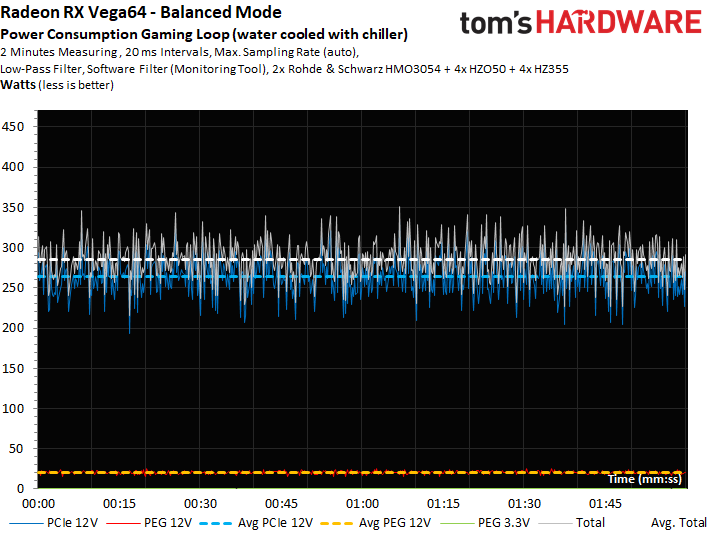

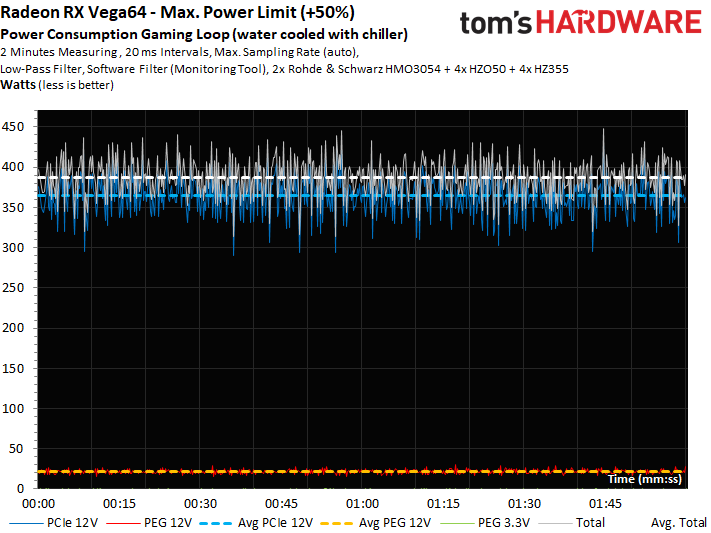
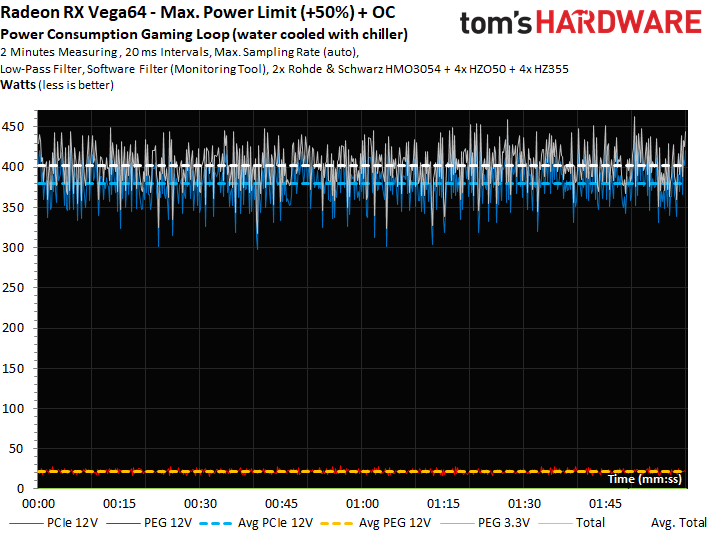
All five power consumption curves appear in order of ascending magnitude.
MORE: Best Graphics Cards
MORE: Desktop GPU Performance Hierarchy Table
MORE: All Graphics Content
Current page: Voltages, Frequencies & Power Consumption
Prev Page Installing Our Water Cooler Next Page Temperatures & A Surprise
Igor Wallossek wrote a wide variety of hardware articles for Tom's Hardware, with a strong focus on technical analysis and in-depth reviews. His contributions have spanned a broad spectrum of PC components, including GPUs, CPUs, workstations, and PC builds. His insightful articles provide readers with detailed knowledge to make informed decisions in the ever-evolving tech landscape
-
TJ Hooker Good article, thanks for the analysis!Reply
Was a similarly indepth look at overclocking/undervolting performance with Polaris done, that I missed? Or is there just whatever is included the various Polaris 10 review articles (e.g. RX 480 review)? If it's the latter, does anyone know which review would contain the most information regarding ths? -
Cryio I don't think this article went in-depth enough. Dunno where I've read, but I've seen Vega 64 consume just half or 2 thirds as much power while only loosing 15% performance. Which is tremendous IMO.Reply -
TJ Hooker Reply
Tom's found something similar to that in their review of the Vega 56, with a 28% reduction in power consumption only costing you an 11% performance hit. http://www.tomshardware.com/reviews/radeon-rx-vega-56,5202-22.html20238896 said:I don't think this article went in-depth enough. Dunno where I've read, but I've seen Vega 64 consume just half or 2 thirds as much power while only loosing 15% performance. Which is tremendous IMO.
But that's going into underclocking, whereas this article was very focused on undervolting and what effect that has on power consumption.
Although it would be very interesting to see an article that looks into tweaking both clockspeed and voltage to see what sort of efficiency can be achieved. -
Xorak Maybe it's too early in the morning for me, but I'm a little confused about what we actually found here.. Looks like the highest overclock was achieved using default voltage and the maximum power limit, with a 3% frequency increase.. Under the condition of using a somewhat absurd cooling solution..Reply
So are we to infer that with an air cooled card, undervolting in and of itself is not desirable, but is likely to help more than it hurts because we run out of thermal headroom before the lower voltage becomes a limiting factor? -
Wisecracker Thanks for all the bench work and reporting.Reply
Tweaking on AVFS appears to be the *Brave New Frontier* (or, "We're all beta testers for AMD" :lol: ). The fancy cooling was impressive but as noted under- clocking/volting brings out unseen efficiencies in Vega/Polaris. That's certainly not at the top of the list of many Tech Heads but gives AMD better insight going forward as they bake new wafers, fix bugs and tweak the arch.
I suspect the nVidia bunch does the same thing, but the woods are filling-up with volt- and BIOS Mods for Polaris and Vega. There's a thread at Overclock pushing 500 pages! Manipulating volt tables is becoming an art ...
More than anything, what I believe this shows is that AMD (and GloFo) boxed themselves into 'One Size Fits All' with gaming cards because of varying consistencies in the chips, and just like desktop Zen they were the last picks of the litter behind the big money makers --- enterprise, HPC/deep learning, Apple, etc.
-
Ethereum Currency The RX Vega 56 has outweighed many other graphics cards as it is fast and has superb graphics: http://rxvega56.zohosites.euReply -
photonboy Do I need a degree on Tweakology to get the most out of an AMD graphics card?Reply
I still can't comprehend how there are so many engineering issues going on with the design of VEGA, as well as the continued challenges in how to optimize an overclock.
You'd think in 2017 you could just tell the computer to figure out the optimal overclock. We get closer with NVidia; I can use EVGA Precision OC to optimize the voltage/frequency profile though even that isn't perfect as it needed to be restarted many times to finish and when done it wasn't stable in some games.
You'd think the graphics card could continually send itself known data to validate the VRAM and GPU at all times (using a very small percentage of the cycles).... oh, errors? Well, then drop to the next lowest frequency/voltage point. Is that so hard? -
ClusT3R Do you have like a manual with the values and the software I want to try to remove more power and add more clockspeed as I can I have vega 56Reply -
GoldenBunip The biggest gains on Vega is keeping the HBM cool. It will click to 1100 then (but no more) resulting in huge performance gains. Just really hope we crack the stupid bios locks soon.Reply -
zodiacfml I don't understand what is going on here.Reply
Why do we have to put an overkill cooling system for the question "cDoes Undervolting Improve Radeon RX Vega 64's Efficiency?
